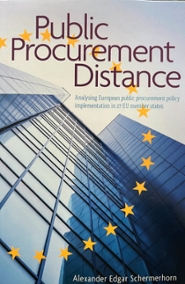European procurement policy is full of good intentions like sustainability and innovation, but in practice it often proves impractical. Researcher and procurement officer Alexander Schermerhorn shows in his dissertation 'Public Procurement Distance' why rules clash with reality.
Procurement and European procurement policy
A procurement procedure is a public invitation by a government organisation for tenders from the market, starting from a specified minimum contract value. This invitation is drawn up in accordance with European purchasing policy. The aim is to have a public contract carried out with the best possible balance between price and quality.
European purchasing policy is built on three pillars:
Legal framework. Mandatory basic rules laid down in national legislation, such as the Dutch Public Procurement Act 2012.
Strategic policy objectives. Non-mandatory but desirable themes, including sustainability, social impact, innovation, and opportunities for small and medium-sized enterprises (SMEs).
Cross-border procurement. Also non-mandatory, but intended to strengthen the internal market by encouraging purchasing across national borders.
You researched why European procurement policy is not always implemented as conceived by the European Commission. What is in this policy?
'According to the strategic procurement policy, buyers are expected to take sustainability, innovation, social return, and purchasing from small and medium-sized enterprises (SMEs) into account. This is generally not mandatory, but implementation is strongly encouraged. The European Commission, for example, wants to purchase green, sustainable, and responsible products, but in practice this proves difficult because buyers often regard it as complex and cost-increasing.
In addition, the EU wishes to highlight the success of a harmonised European market. Therefore, the European Commission expects buyers in the Member States to procure as much as possible across borders in other Member States. If you look at the Netherlands, people do not readily turn abroad because much can already be sourced domestically. Cross-border procurement is therefore rather rare, which shows how European policy often fails to materialise in practice, resulting in what is also the title of my dissertation: public procurement distance.'
You conducted a survey in 27 Member States to find explanations for this distance. What stood out?
'I examined the workplace of how buyers apply European procurement policy. Here, intrinsic motivation turned out to be an important factor. If it is lacking, the motivation to implement the desired policy in practice is much weaker. Another striking point is how procurement officers deal with problems. If they have to solve an issue ad hoc, the procurement policy is adjusted in such a way that a pragmatic solution is reached.
I was also curious whether cultural differences play a role in the emergence of procurement distance, but in practice those differences hardly exist. You could, for example, place a buyer from Helsinki in Cyprus and, broadly speaking, he or she would apply the procurement policy in the same way, which is quite interesting.'

Why is that interesting?
'Everything in the public space around us has been procured. Literally everything has at some point been tendered and requested through an offer. What is interesting is that we usually do not reflect on the scale and impact of this. That is precisely why it is important to look at how procurement policy is actually implemented in the European Union. This gives a much clearer picture of how things function on the ground and the problems that arise there.'
If you could advise Brussels on one thing they should implement immediately, what would it be?
'At present, a major revision of the European procurement directives is taking place. Policymakers in Brussels sometimes have a tendency to draft very detailed procurement regulations. But in this case, I would say: create fewer rules and leave more to practice. Buyers must be able to implement procurement policy independently and be intrinsically motivated to do so. My research shows that implementation is adjusted to such an extent that it makes little sense to lay down every square inch in regulatory detail.'
Why did you want to investigate this?
'I myself work as a government buyer and often see that implementation differs from what was expected in advance. I wondered why this was the case. Suppose I need to purchase 100,000 nails that must meet technical requirements. Whether or not they are sustainable, come from an SME, or from across the border, is for me as a buyer at that moment less important than completing the procurement successfully. And that is the crux of the matter: policymakers can impose rules in advance, but in practice the implementation turns out differently. From that curiosity, I started this research into procurement distance.'
What would you like to see for the future?
'From a scientific point of view, I hope my colleagues will continue to research what happens in practice. The actions of managers, policymakers and politicians are widely studied, but it is also important to look at the people with their feet in the mud.'






